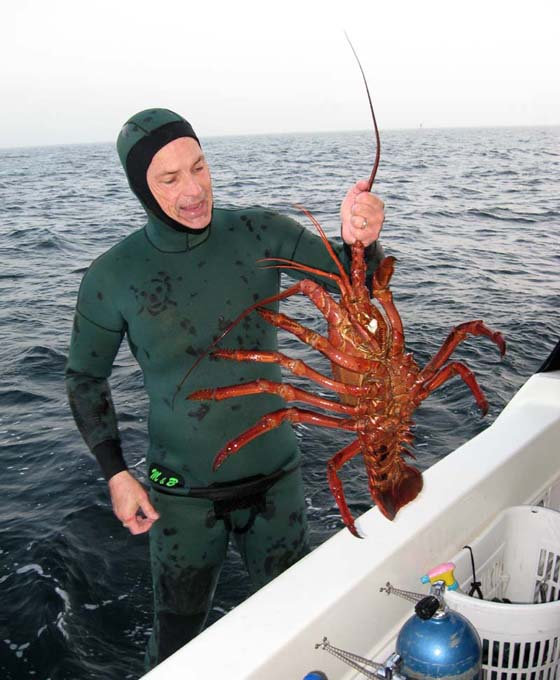CopyRight @ 1997
First you have to find the lobster....
If your intent is to grab a lobster,
if you can release your ancient hunting instincts,
if you are ready to strike at the fastest speed you can move,
if you are psyched up to your greatest possible focus and attention,
if you don't hesitate,
you can grab lobsters before they can start to move which is usually just about 1/10 of a second
after they figure out that you are there.
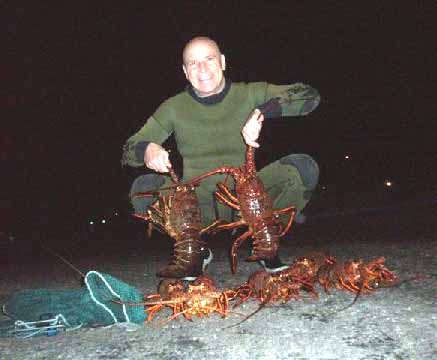 |
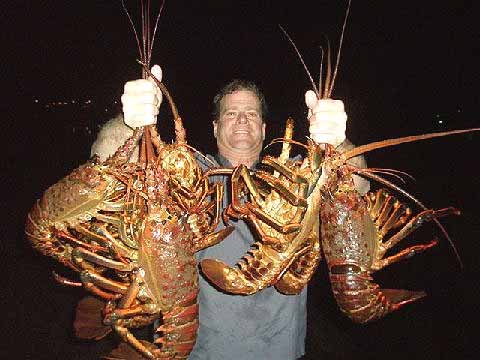 |
In California, lobsters are fairly common from the Mexican border
up to Point Conception. They do show up occasionally at Shell Beach
past Pismo, but these are a bit uncommon. Supposedly, the Halibut
netters occasionally get real big ones out in the sand there.
Your eyes are how you detect lobsters. There are huge nerves between your eyes
and your brains. 80% of the traffic on those nerves is from your brain to your
eyes, not from your eyes to your brain. What this means is that your brain is
constantly telling your eyes to look for certain patterns. You should be completely
psyched up for lobster hunting with clear pictures in your mind of what you are
looking for. Just about every stray strand of drifting eel grass should instantly
look like a lobster antennae to you.
Most lobsters are taken with the swat. Pin them down to the rocks. Then get your fingers
around them and put them in the bag. Only grab a lobster when a swat won't do. You miss
far more grabs than swats. They say to grab a lobster towards the tail so that if it starts
moving backwards you will still get it by the body. If you can grab at the lobster from the
top, you should be swatting it anyway, not grabbing. A grab is generally for when all you can
get a hold of are the antennas. A good hunter can use a sideways swipe, fingers up, thumb down,
when lobsters are looking out from a shelf.
I know of two basic ways to find lobster in the day. The first is
to look for the hidden ones by checking holes. The second method is to
just cover ground to look for antennas. The second method is how the
big ones tend to be found. The way to get the most bugs is to cover
the most ground.
Watch a very cool catch
Lobsters are social. When you find one, there are probably more.
Often, you just swim along and see hole after hole with no lobster and
then all of a sudden, there they all are. It often seems like lobsters
choose their holes by committee. You see all these empty holes that
could put 100 lobsters out of reach and they will be empty. Then you
find 5 in a hole where they have no where to go.
At places like San Nicolas, where there may not be many hiding
places for lobster, you just swim as fast and far as you can,
following any contour of the terrain, looking for a hidey hole that may
be full of big bugs.
Lobsters like rock piles. If you find the right one, there may be
lobster looking out of every other hole.
Something I do that is a good way to find lobster, is move in or
out from the island until you find a geologic strip of rock that that
has left many broken up rocks and boulders. Follow this geologic
feature. There are likely to be lobsters in the rocks, but this is not
where you will find the biggest ones. You can do this at San Nic,
Santa Barbara Island and Talcott Shoal.
When you find lobsters together, you must try to take them so
that they do not panic the rest. You may get a grab at another one.
For those unfamiliar with lobster diving, realize that the
lobster hides during the day. It's instincts are tuned this way to
avoid getting eaten by their natural predators, Sea Otters and
Sheephead fish. They
position themselves backwards in a hole that they can escape into,
with their sensitive antennas sticking out the front. If they feel
vibration in the water, they back into the hole. If they get panicked,
they flap their big tail and are propelled like a jet, backwards.
Normally a lobster picks a hole that is deep enough and small enough
that if they retreat into it, they are completely out of reach. Some
of these holes go to near the center of the earth. Occasionally,
largely depending on the terrain, the lobsters may be forced to take
up quarters in a hole that is not so deep. This makes hunting far
more feasible and is the situation commonly found around the west
end of San Nicolas Island.
Sometimes, big bugs, say 7 pounds or more, don't bother to hide
in the day. They may just lean against a rock. This is really rare,
but I have seen it. If there were otters here still, I would expect
this to be even more rare.
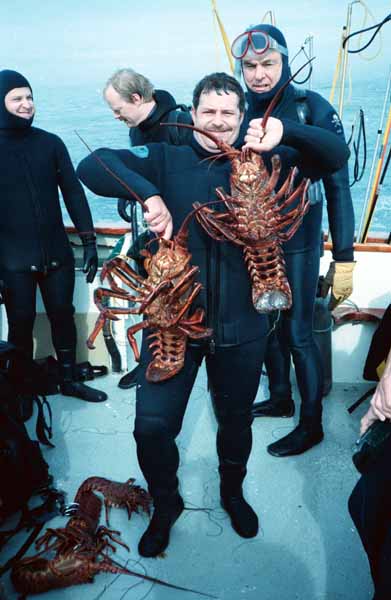
Wayno was one of the all time best bug hunters. So are the two guys behind him, Shel and Lee.
Catching Lobster
The first rule of lobster grabbing is to avoid getting urchin spines in your hand. While sometimes this rule is ignored, especially for big bugs, it is self enforcing and so should rarely be ignored. In the 80's and 90's the urchin harvesters made it easier by removing a lot of the urchins. Now that the fishery has moved, the urchins are getting thick again.If you want lobsters, swim as far and fast as you can. Cover territory. This is especially true if you want big bugs.
He who hesitates doesn't get bugs. Nail them before they can register your presence.
Conditions are different each year and each area is diffrent, but at the beginning of the season, lobster tend to be deeper, often past 60 feet. By the end of November, they will have come in shallower. By January, a lot of them are right near shore. By the end of the season, they are thinking of reproduction and so may be very shallow. They may also ignore divers.
When it comes to lobster hunting there are two basic ways to do it and they are as different as night and day. That is, you can hunt them in the night or the day. There are advantages to both and differences in methods for both as well.
The nice thing about hunting at night is that the lobsters may be out walking around looking for food or a date. If not walking, they may be farther out of their hole than they would be in the day. This is because their instincts make them hide during the day to avoid predators including fish and especially sea otters.
At night, don't wave your light around too much. You don't want to alert the lobsters that are out of reach. This also means that actually, you can very successfully hunt with a rather small light. It makes the diving a bit harder, but seems fine for hunting.
If there is some current, head for the leading edge of the reef or look for rocks sticking up in the current. The bugs hang out there.
If you see loads of squid at night as occasionally happens, swim over the sand. The lobsters may be out feasting.
When you reach the sand at the bottom of the reef, wave your light over the sand and look for little bright red lobster eyes reflecting back.
Most lobster taken though, are taken buy the quick grab or flatten method. A diver swimming rapidly, that comes up on a lobster suddenly, may be able to immediately grab the lobster or flatten it against the rocks, before it can start to move. If the first grab misses, the diver may get another chance as the bug moves back in its hole. Probably not. If the diver does get some kind of grip on the lobster in its hole, pulling on legs or antennas will not work, because they will break off before the lobster will get pulled out. If you can get some grip on the lobster and pull it out quickly, that is fine. Normally what happens though, is that the diver gets a finger and a thumb on the base of the lobster's antennas. This small piece at the base of the antennae will not normally pull off. It has spines though that make it almost impossible for the diver to move their hand up the antennae onto the lobster, for a better grip. By now, the lobster has managed to get a death grip on the rocks with all of its legs. What this makes for is an interesting tug-a-war. Sometimes, shaking will disorient the lobster and it will loosen its grip. Really, this is a close competition and the lobster has the edge. If your hand slips, the bug is gone. At this point, some you get, most you don't.
Speed and the sudden swat is the most successful method of bagging a lobster. Shallow hiding holes are really nice too.
Big Bug
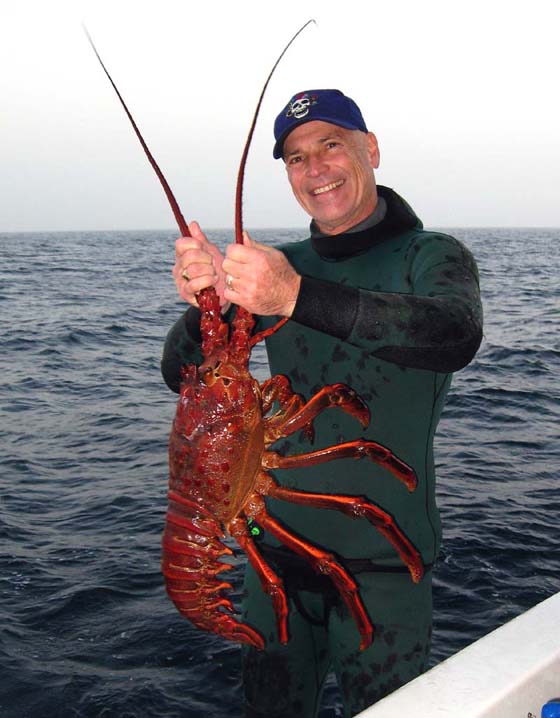
Legs
The Downside of Lobster grabbing
Speed and the sudden swat is the most successful method of
bagging a lobster. There is one drawback to this though, Lobsters are
usually in holes that also contain Sea Urchins. A wild grab can make
for a trip to the hospital to get spines removed. It is really easy
to get stabbed deep and have a spine break off inside. Yes, if it is
not immediately a problem, you can wait for it to dissolve... in 2
years, but urchin spines can really screw you up.
One of the best things to come along for lobster hunters has got to
be the Kevlar gloves they sell these days. They are great and
mostly protect against urchin spines.
It is interesting when a diver goes bombing into a vertical crack
after a lobster and they end up with urchin spines sticking through
their hood into their forehead.
You have to be more than quick and aggressive. You have to be very
accurate and make quick judgments.
Often, when trying to get a lobster, you end up reaching blindly
into holes and groping around to try to feel the bug. This can have
some drawbacks besides Sea Urchins. There is a gray sponge that
collects silt. it is fairly common in holes and is incredibly slimy
to the touch. Also if you get really lucky when
you reach in a hole, you just may grab a puffer shark. Talk about
mushy. Make you want to heave. The worst thing you could grab, has
got to be the Sculpin or Scorpion Fish. The name says it all. If you
get spined, you may be able to denature the toxin with extremely hot
water. Good luck. You should not have done that. Sculpin are less common
north of Santa Barbara Island.
That's about all you have to worry about grabbing when reaching
in a hole. I guess that there is one other thing to think about
though. That's what might grab you. If you approach a lobster and one
antennae points forward and one points back, the back one is probably
pointing at a moray eel. While morays are seemingly not aggressive, as
we are told, anything with that many teeth that are that sharp, has an
oral fixation that doesn't end. There are fewer morays north of Santa
Barbara Island. There used to be far more than there are now. I used
to claim that Catalina was a rock floating on morays. I saw 30 divers
go down where there were bugs everywhere. None were taken. There were
morays in every hole that held a lobster.
At Church Rock, Catalina Island, I found out about those sharp
teeth. I was actually taking abalone and had pried one off that fell
in a bit of a hole. I couldn't see in easily and just reached for it.
My glove got shredded and so did my fingers. It was not all that bad
and could have been worse. The moray just snapped at me a bit as his
way of telling me to go away and thanks for lunch. Those teeth had to
be incredibly sharp to do what they did to my leather gloves.
When I got bit I reached in the hole blind. It didn't come after
me. Put it this way. At Catalina, San Clemente or Santa Barbara
Islands, I do not reach in a hole without looking with a light first.
I don't worry about it elsewhere... I wonder where they all went. No one
regularly hunts morays, but they used to be far more common than they are now.
Measuring Lobster
1. Unless you have filed for a multi-day permit with the Fish and
Game, you can have a maximum of 7 lobsters in your possession.
2. A lobster must be at least 3 1/4 inches from the back of
the carapace to between the big horns on the head.
Actually, F&G officers usually measure by putting the
gauge at the back of the carapace and then if the other
end can come down to move the eyes, they call it illegal.
3. Then there is Chris' way of figuring size underwater:
Getting Them Home Fresh
Lobsters are intertidal, so they can survive quite a while out of the water. They will last longest if they are kept cool, moist and out of the sun.Most boats going to the islands will have a live game well to keep them happy during the trip and on the way home. It is a good idea to bring an extra game bag on a dive boat so that you can put your catch into the game well while you do more diving.
While your catch should make it home just fine if they are just put in an ice chest, for a long trip or if it is hot, toss them in an ice chest with kelp on top or a saltwater soaked towel. This will keep them healthy for a much longer time.
Freshwater or too much ice will drown them and ruin the meat.
If you are on a boat and don't have a live game well, lobsters will live a long time if they are placed under towels or burlap and then are soaked regularly with seawater.
Caribbean Lobsters
Caribbean lobsters are tasty and fun to eat. They are a different specie than the California
lobsters. Actually there is more than one specie, but usually it is considered Panulirus argus.
I think they pretty much taste the same, maybe not quite as good, but in any case, they are
fun to hunt.
There are lots of different laws depending where you are, but how you hunt them is very different
than California, because the rules are designed to protect the fragile coral reefs. They do not
want you grabbing at a lobster and leaving a crater in the coral. In the Bahamas you are only
allowed to spear them. In Florida, you can take them by two main methods. A lot of people use an
angled "tickle stick" about 30 inches long to coax them out of their holes and then they swat them
with a net that is about 14 inches across. My preferred method is to use a noose. You have a stick
about 40 inches long with a nylon (or I've even seen braided cable) running through it to make a
noose at one end. You get the noose behind the lobster, slide it over their tail and pull the noose
tight. It works really good and sure is a lot easier than grabbing by hand. I got the impression that
a lot of divers had a hard time using the noose. From my experience I thought it might be because it
is hard to get the noose behind the lobster without touching the tail. even a soft touch will be too
much. I learned to bull the noose up tight, put the stick behind the lobster and then push out the
loop before sticking it around the tail. That worked well.
Florida has more than just one season. They open it for a weekend early called the "Mini-Season" and
everybody goes nuts. Then about a month later is the regular season. The size limit is smaller their too.
It is 3 inches across the caripice from front to back. Some of them get very big though, at least in
the 9 pound range.
Hawaii Lobsters
I got lucky enough on a couple occasions to hunt lobsters in Hawaii on the Islands of Maui and Kaui.
They are sort of blue, but they taste great. The coral is not as fragile as in the Caribbean and they
tend to hide in the holes in the volcanic rocks, so
you can grab them with little damage. Sometimes they are in small holes called "Puka Holes". It's fairly
easy to grab them then. I had a great night dive for lobster off of Maui. The water is so clear that
night diving is an experience. You can even find an occasional Slipper Lobster there, but I never did
get one.
Cheating
So what can I do to get them pesky things. You will see far more
lobsters that are out of reach, than you will get in your bag.
Legally, lobsters can pretty much be taken by divers only by hand or by
a hand in a glove. Of course there are other methods for
coaxing them out of their holes. Serious lobster hunters
have devoted a fantastic amount of time and imagination
into trying to solve the problem of getting lobsters that
are out of reach. I would probably hesitate to discuss
this topic much, except that most methods just don't work.
Some are amusing though.
There are a variety of methods to try to entangle the lobsters.
I hear that in Florida, people will stick a mop in a hole and
try to get the lobster tangled in it. I hear that it actually
works, but I suspect that it would be so conspicuous that you
would likely get busted. Related to this, but better is using
panty hose to entangle them. I don't know how you manage this,
but I do know someone who tried. They failed and also said that
they managed to get really embarrassed when the panty hose fell
out of their BC pocket onto the deck.
In Florida, nooses are legal to use. Again, these would be
very conspicuous and could get a person a ticket. They also
don't work as well here, because the holes are usually deeper
than in Florida.
Using some sort of gaff is harder than it sounds and if the F&G
find a puncture hole in the lobster (and they do look) you will
get a ticket.
My favorite method is to gently rub the rubber band of a pole
spear along their back. The idea is to convince them that there
is a octopus in the hole with them so that they leave the hole.
You have to be very gentle with this technique, don't stir the
water any and don't move such that the lobster can see your
silhouette. It has never worked for me in the many times I
have tried it, but it does seem like a good idea. It does work
with a real octopus, but that's a little ahrder to manage.
Lobster hunting is one of the most exciting, challenging and fun
things you can do under water, then you take them home and eat
them. For Lobster Recipes and
For The Lobster Picture Gallery
Enjoy the diving, seahunt
Back To Start
addendum... I was asked why not just take pictures of them... This is what I said.
Ya know, you got me to think about this again. As something of a trophy hunter myself,
(and being way to introspective for anyone's mental health) I've sometimes asked
myself about photographing game rather than taking it. Sure, I love preparing the
exotic dishes you can with wild game and I love the get togethers that I tend to
arrange with family and friends to enjoy the dishes. Still, aside from that I am
extremely concious of the environment. If I thought that to preserve the ecology, it
was important not to hunt, I wouldn't. The food isn't that important. I am sure that
it would be (mostly) better for the ecology if no one hunted or fished, but that
doesn't seem practical. We too are animals in nature. Really, as it is with just
about every thing human, we need to strike a balance.
Still, why hunt? Why not take a picture instead? We hunt for a number of reasons, but
it almost always comes down to the challenge and excitement. Hunting is in human genes.
We were designed for it. When we hunt, our senses reach their highest level of
sensitivity. Every sign from the environment is read and evaluated for a trail to
our game. Hunters love the long fast swims over the open areas looking for any
habitat in the gloom. Hunters glide along the thick growth of the shallow reefs,
searching in a complex labrinthe of rocky crevasses hidden within a thick moving
golden kelp garden. They all act as any predator to find and strike at their prey
before it is wary and disappears. Often times it turns into battle to catch or to
escape... depending on your side of the battle. At that point, the lobster often
wins. All hunters know the how long it took to develop their skills. All hunters
know that each hunt will be a challenge that will take all their alertness, stamina
and skill for success. Mel is good enough to make it easy.
I'm sorry, but compare the two. I love photography, but seriously, is photography
anywhere near that exciting?
Think about the gulf for a hunter between I almost got it and it's in the bag. It can
be 1/100th of a second or a 1/10th of an inch. Taking a picture just doesn't present
the challenge. Lobsters are not going to go the way of the Dodo any time soon. Worry
about warm water if you want something to worry about in the ecology.
What about taking the big ones. Won't they get smaller over time?
That's actually not the reason the lobster hunters like Mel let the big ones go though.
It is the belief that the big ones are better breeders, because they always seem to
have harems.
I also question how it applies to lobsters for a couple reasons including that their primary
predator, the otter, is generally gone.
Enjoy the diving, seahunt
